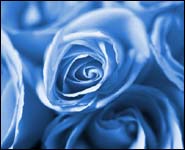May 07, 2004
Going for Blue
Scientists Say They're Close to Creating the Blue Rose

May 7 ? Giving mom a rose for Mother's Day? Thanks to an enzyme found in human liver, it might soon be possible to present her with the flower industry's Holy Grail: A blue rose.
Roses already come in an endless array of colors from pink to yellow to peach to red to striped. But, despite more than 15 years of trying, no one has been able to create a natural blue rose.
In the $1.2-billion-a-year global rose business, achieving what would be a truly unique bloom would mean instant profits.
"A lot of wealthy people are rose fans and anything unique sells for high prices," says Robert Skirvin, a hortoculturalist at the University of Illinois at Urbana-Champaign. "There's quite a market."
Now a surprise finding in a medical lab at Vanderbilt University in Nashville, Tenn., may have finally placed the blue rose within reach.
But just what makes the flower so unattainable? Apparently in nature, blue is a very complicated hue.
Complex Mix
The rare blue color in petunias, for example, relies on a mix of genetic and environmental cues. There's the pigment called delphinidin that creates the color, then there are co-pigments, required to bring out the blue tint.
Finally, just the right balance of acidity is needed inside the cells of the plant to ensure the right shade of blue is expressed.
The rose, in its current versions, lacks all three.
"The rose is not easy to work with," says David Byrne, a rose geneticist at Texas A&M University in College Station. "It has no blue pigments and it can't seem to go through the transformation process."
Scientists have tried grafting, cross breeding and introducing genes extracted from petunias. But none of these attempts have led to a blue bloom.
In 1986 a biotech company, Florigene, was founded in Melbourne, Australia with the single goal of creating a blue rose. The company's researchers have come close with lavender versions and even a line of blue carnations. They still haven't claimed making a blue rose, although they're coy about just what they've accomplished.
"It depends on how you describe blue," says John Mason, research manager at the Victoria, Australia-based company. "This is a very sensitive topic for us and unfortunately I cannot comment further."
Human Liver Offers Enzyme
Any developments toward achieving the blue beauty will remain top secret, Mason explains, until Florigene announces it has a blue rose. Meanwhile, medical researchers in Tennesse think they may have stumbled upon a shortcut.
As will be detailed in the Journal of Medicinal Chemistry, biochemist Peter Guengerich and his assistant Elizabeth Gillam were in the process of trying to understand how the human liver breaks down drugs when they came across a human liver enzyme that had a startling effect.
"When we moved the enzyme into bacteria, the bacteria turned blue," he says. "It was a complete surprise."
Guengerich's main interest lies in understanding how humans process drugs, but Gillam pointed out the blue bacteria could be a boon in the flower business. The team tried inserting the liver gene that creates the enzyme into a rose.
So far the results have been ? spotty.
"The first time we tried we got blue spots on the stems," Guengerich says. "Those probably aren't going to be too marketable."
Still, the team continues to try new ways of introducing the human liver gene to roses and believe it's only a matter of time.
"We really think we can get a stronger color using the human gene," he said, explaining that using the human liver enzyme may be easier since the enzyme seems to generate the color using a simpler process.
Thorn-Free and Sweeter Smelling
Meanwhile researchers are working on tweaking other features of the famous flower. Skirvin, at the University of Illinois at Urbana-Champaign, has developed rose bushes that have no thorn.
"It's a very unstable characteristic," he says of the thornless roses. "But we have two plants that are completely thorn-free."
Others are working on developing roses that smell sweeter by taking genes from wild, sweet-smelling blooms and inserting them into blander versions. That work has already led to fragrant results.
As for the blue rose, for now the only sure way to create one may be the old-fashioned, artificial way: Dipping it in dye.
Posted by thinkum at May 7, 2004 01:56 PMThe limits of my language mean the limits of my world. by free online poker
Posted by: free online poker at December 26, 2004 12:26 AMtexas holdem - texas hold'em, poker tournaments | free online poker - texas hold'em poker, internet poker | poker rooms - poker rules, poker stars | poker tables - poker online, party poker | poker games - texas holdem poker, partypoker | empire poker - empire poker, poker stars | poker chips - poker games, wsop | online poker sites - partypoker, pacific poker | online poker sites - free poker online, poker games | wsop - poker books, texas holdem | world poker tour - empirepoker, WPT | paradise poker - poker, texas holdem poker | poker supplies - free poker online, online poker sites | world poker tour - texas holdem poker, empire poker | world poker tour - poker rooms, poker chips | online poker - poker online, texas hold'em poker | poker tips - poker rooms, free poker online | texas hold'em poker - world series of poker, texas holdem poker
Posted by: poker at February 17, 2005 12:49 AM